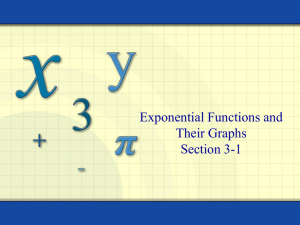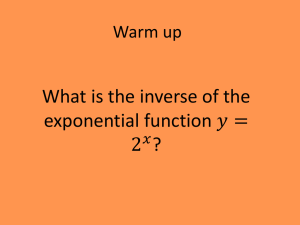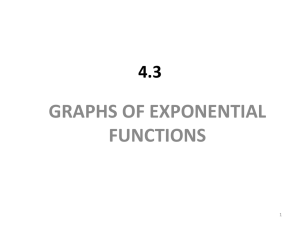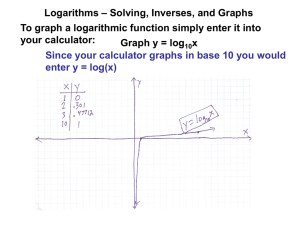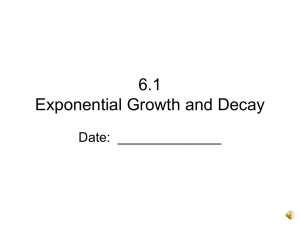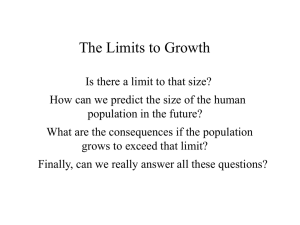171S5.1_p - Cape Fear Community College
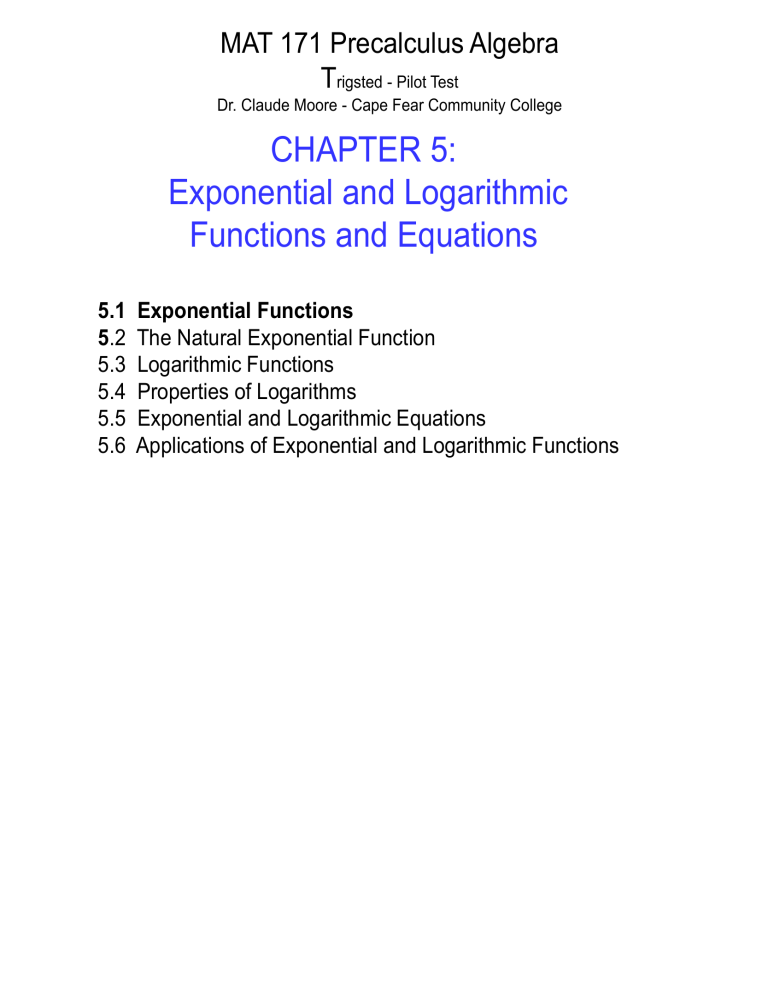
MAT 171 Precalculus Algebra
T
rigsted - Pilot Test
Dr. Claude Moore - Cape Fear Community College
CHAPTER 5:
Exponential and Logarithmic
Functions and Equations
5.1 Exponential Functions
5 .2 The Natural Exponential Function
5.3 Logarithmic Functions
5.4 Properties of Logarithms
5.5 Exponential and Logarithmic Equations
5.6 Applications of Exponential and Logarithmic Functions
5.1 Exponential Functions
· Understand characteristics of exponential functions.
·Sketch graphs of exponential functions using transformations.
·Solve exponential equations by relating bases.
·Solve applications of exponential functions.
Omit Present Value on pages 5.1-21-23;
Example 7.
Exponential Function
The function f(x) = b x , where x is a real number, b > 0 and b ≠ 1, is called the exponential function, base b.
Th e base needs to be positive in order to avoid the complex numbers that would occur by taking even roots of negative numbers.
The following are examples of exponential functions:
Graphing Exponential Functions
To graph an exponential function, follow the steps listed:
1.
2.
Compute some function values and list the results in a table.
Plot the points and connect them with a smooth curve. Be sure to plot enough points to determine how steeply the curve rises.
Example
Graph the exponential function
y
=
f
(
x
) = 2
x .
Example
(continued)
As x increases, y increases without bound; as x ∞ , y ∞.
As x decreases, y decreases getting close to 0; as x ∞ , y 0.
The x-axis, or the line y = 0, is a horizontal asymptote . As the xinputs decrease, the curve gets closer and closer to this line, but does not cross it.
Example
Graph the exponential function
This tells us the graph is the reflection of the graph of y = 2 x across the yaxis. Selected points are listed in the table.
Example
(continued)
As x increases, the function values decrease, getting closer and closer to 0. The x axis, y = 0, is the horizontal asymptote .
As x decreases, the function values increase without bound.
Graphs of Exponential Functions
Observe the following graphs of exponential functions and look for patterns in them.
For the base between 0 and 1, the graph goes DOWN toward the x-axis to the right.
For the base between greater than 1, the graph goes UP to the right.
Example
Graph y = 2 x
–
2 .
The graph is the graph of y = 2 x shifted to right 2 units.
Example
Graph y = 5 – 0.5
x .
The graph y = 2 -x is a reflection of the graph of y = 2 y = - 2 -x x across the y-axis ; is a reflection across the x-axis; y = - 2 -x + 5 or y = 5 - 2 x is a shift up 5 units.
Graph 3
Graph 1
Graph 4
Graph 2 y = 5 H.A.
1
Find the exponential function f(x) = b x whose graph is given as follows.
See the animation for the solutions. http://media.pearsoncmg.com/ph/esm/esm_trigsted_colalg_1/anim/tca01_anim_0501ex04.html
The amount of money A that a principal P will grow to after t years at interest rate r (in decimal form), compounded n times per year, is given by the formula given below.
403/10 . Math the function with one of the graphs: f(x) = 1 - e x
403/14 . Graph the function by substituting and plotting points. Then check your work using a graphing calculator: f(x) = 3 -x
403/20 . Graph the function by substituting and plotting points. Then check your work using a graphing calculator: f(x) = 0.6 x - 3
403/4 . Find each of the following, to four decimal places, using a calculator.
403/34 . Sketch the graph of the function and check the graph with a graphing calculator. Describe how the graph can be obtained from the graph of a basic exponential function: f(x) = 3 (4 - x)
404/50 . Use the compound-interest formula to find the account balance A with the given conditions:
A = account balance; t = time, in years; n = number of compounding periods per year; r = interest rate; P = principal
405/58 .
Growth of Bacteria Escherichia coli.
The bacteria Escherichia coli are commonly found in the human intestines. Suppose that 3000 of the bacteria are present at time t = 0. Then under certain conditions, t minutes later, the number of bacteria present is N(t) = 3000(2) t/20 . a) How many bacteria will be present after 10 min? 20 min? 30 min? 40 min? 60 min? b) Graph the function. c) These bacteria can cause intestinal infections in humans when the number of bacteria reaches 100,000,000.
Find the length of time it takes for an intestinal infection to be possible.
407/76 . Use a graphing calculator to match the equation with one of the figures
(a) - (n): y = 2 x + 2 -x
407/82 . Use a graphing calculator to match the equation with one of the figures (a) - (n): f(x) = (e x + e -x ) / 2
407/84 . Use a graphing calculator to find the point(s) of intersection of the graphs of each of the following pairs of equations: y = 4 x + 4 -x and y = 8 - 2x
- x 2
407/88 . Solve graphically: e x = x 3

